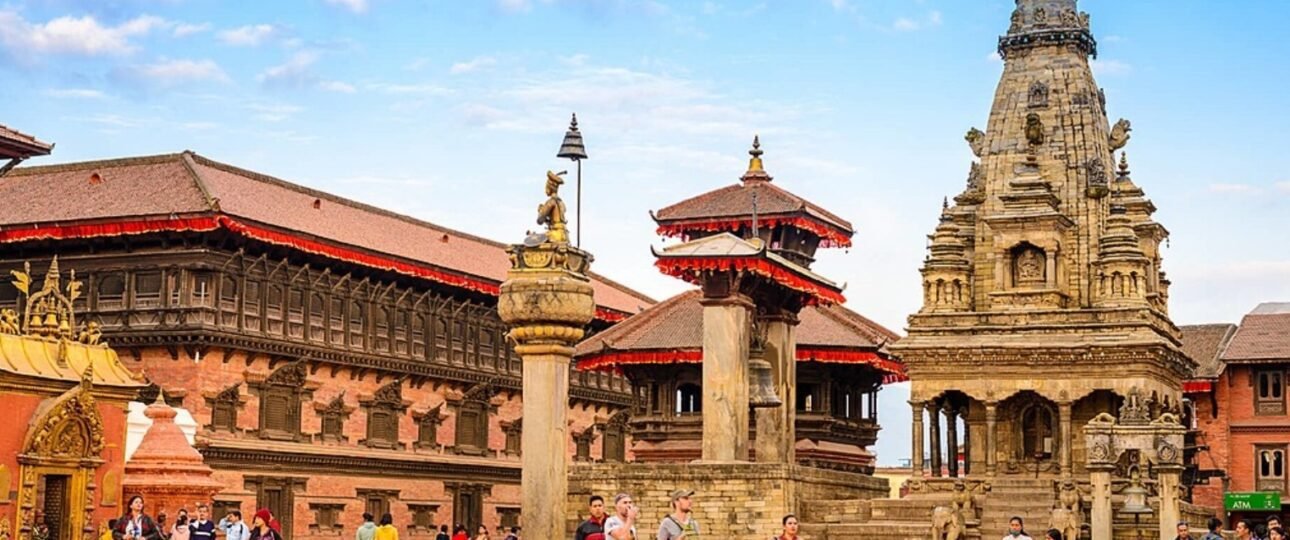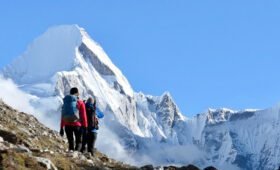Nepal boasts a remarkable abundance of cultural and natural diversity, as evidenced by its inclusion of 10 UNESCO World Heritage sites. These sites, encompassing both natural wonders and cultural treasures, have been recognized by UNESCO for their outstanding universal value.
Nepal boasts four UNESCO World Heritage Sites, two of which are Cultural World Heritage Sites – the Kathmandu valley and Lumbini – and the other two are Natural World Heritage Sites – the Chitwan and Sagarmatha National Park. The Kathmandu valley and Sagarmatha National Park were the first to receive this designation in 1979, followed by Chitwan National Park in 1984 and Lumbini in 1997. These sites are renowned for their cultural and natural significance, offering visitors a glimpse into the rich history and diverse beauty of Nepal. Here are the top 10 UNESCO World Heritage Sites in Nepal.
Pashupatinath Temple
If you are planning to engage in Trekking in Nepal, it is highly recommended that you also partake in a 1/2 day Heritage tour. Nepal is home to one of the most revered Hindu temples in the world, Pashupatinath. This ancient temple, dedicated to Lord Shiva, holds immense significance. The temple complex comprises the main temple, surrounded by smaller temples, ashrams, and sculptures. It is situated alongside the sacred Bagmati River, which adds to its spiritual aura. While entry to the main temple is restricted to Hindus, visitors of all backgrounds are welcome to observe the rituals and ceremonies from the hills overlooking the Bagmati riverbanks. Witnessing these sacred practices, as well as the funeral rites, can be a captivating experience for tourists. The temple’s popularity is evident from the multitude of pilgrims it attracts, especially during holy occasions like Teej and Shivaratri, where the number of visitors can reach hundreds of thousands in a single day. It is worth noting that the Pashupatinath Temple holds such cultural and historical significance that it was among the first sites in Nepal to be recognized as a UNESCO World Heritage Site in 1979. Therefore, including a visit to this remarkable temple in your itinerary would undoubtedly enrich your exploration of Nepal’s heritage.
Baudhanath Stupa
If Pashupatinath is considered the holiest Hindu temple in Kathmandu, then the Boudhanath Stupa serves as its Buddhist equivalent. The origin of this remarkable stupa is surrounded by numerous Newar and Tibetan Buddhist myths and legends, although some historical records suggest that it was constructed by Licchavi King Sivadeva as early as the 5th Century CE. In the present day, it stands as one of the largest Buddhist stupas worldwide, with the entire surrounding area being a settlement predominantly inhabited by Buddhists, housing over 40 monasteries in close proximity. The Stupa attracts a significant number of tourists, pilgrims, and locals on a daily basis, each with their own individual motivations. The ambiance of this location is characterized by chanting monks, spinning prayer wheels, flocks of pigeons, and the fragrance of incense, among other factors that contribute to its unique atmosphere.
Swoyambhunath Stupa
The Swayambhunath Stupa, an ancient monument in Nepal, has a deep connection to the origin of the Kathmandu valley. Historical records and inscriptions have traced its origins back 1500 years, while religious myths and stories date even further. According to legend, the self-sprung Swayambhunath Stupa emerged after the drying out of a lake, giving birth to the present-day valley. This hilltop stupa is a remarkable fusion of Hindu shrines and Buddhist stupas, showcasing the harmonious coexistence of these two distinct architectural styles. Notably, the staircase leading to Swayambhunath consists of 365 steps. Apart from its significance as a sacred site for both Hindus and Buddhists, its strategic location offers a breathtaking panoramic view of the majority of the Kathmandu valley.
Changunarayan Temple
Changu Narayan, a Hindu temple dedicated to Lord Vishnu, is situated on a high hilltop known as Changu or Dolagiri and is surrounded by a forest with a champak tree and a small village called Changu Village. It is considered the oldest temple in Nepal and is located approximately 14 kilometers east of Kathmandu. The temple, along with its various statues, stone inscriptions, and pillars, dates back to 464 AD. Visitors can explore the rich history and fascinating myths of Changu Narayan at the information center and museums located nearby.
Kathmandu Durbar Square
The Kathmandu Durbar Square, also referred to as the Hanuman Dhoka Palace, is one of the three durbar squares located in the Kathmandu Valley. It served as the former royal palace and courtyard for the Mallas and Shahs of Kathmandu, and boasts a multitude of temples and shrines. The primary palace complex was constructed in the 15th century, with additional buildings and monuments added over time. Visitors can explore several notable attractions, including the Hanuman Dhoka monument, Taleju Mandir, Nine Storey Basantapur Tower, Sundari Chowk, Tribhuvan Museum, King Mahendra Memorial Museum, and the Kal Bhairab temple located nearby.
Patan Durbar Square
The Patan Durbar Square, akin to the Kathmandu Durbar, served as the former palace of the kingdom of Patan/Lalitpur. It is believed that the town was named after King Yalamber, as Patan translates to Yala. Situated approximately 8 km south-east of central Kathmandu, this palace complex is a remarkable display of Newari architecture and craftsmanship. The courtyard is adorned with numerous Hindu and Buddhist monuments. Historical records indicate that Emperor Ashoka constructed certain parts of this Square as early as the 3rd century BCE. Notable attractions in Patan Durbar Square include the Mahaboudha Temple, Kumbeshwor temple, Krishna Temple, Golden Temple, Jagat Narayan Temple, Hari Shanker temple, Vishwanath temple, Bhimsen temple, and Rato Machhendra Temple, among others.
Bhaktapur Durbar Square
The Bhaktapur Durbar Square, situated approximately 12 km east of Kathmandu, is the final of the three ancient palaces in the city. Bhaktapur, also known as Khwopa or Bhadgaon, is a medieval town that boasts of the finest examples of Nepali architecture and craftsmanship. The Bhaktapur Durbar Square comprises four squares, namely Durbar Square, Taumadhi Square, Dattatreya Square, and Pottery Square. It is home to several notable landmarks and monuments, including the Lions Gate, Golden Gate, Art Gallery, Statue of King Bhupatindra, Nyatapola Temple, and the fifty-five windowed Malla palace.
Lumbini
Situated approximately 300 kilometers southwest of Kathmandu in the plains of Terai, Lumbini holds great significance as a religious pilgrimage destination with a rich historical background. It was bestowed with the prestigious title of a UNESCO World Heritage Site in 1997, making it the fourth location in Nepal to receive this honor. Lumbini is renowned worldwide as the birthplace of Gautama Buddha, also known as Siddhartha Gautama or Shakyamuni. Gautama Buddha, a prince belonging to the Shakya dynasty, lived during the 3rd to 4th century BCE and embarked on a profound spiritual journey that led him to attain enlightenment and become the Buddha. His teachings, known as Buddhism, have transcended time and geographical boundaries, spreading across the globe. Consequently, Lumbini holds immense religious significance for Buddhists. The prominent attractions to explore within this sacred site include the Maya Devi Temple, Sacred Garden, World Peace Pagoda, China Temple, Thai Monastery, Burmese (Myanmar) Temple, Nepal Buddha Temple, Dharmaswami Buddhist Monastery, and Tilaurkot Palace.
Chitawan National Park
The first national park of Nepal, the Chitwan National Park (formerly known as the Royal Chitwan National Park), was established in 1973 and spans over 952 sq. km. Visitors can partake in a variety of thrilling activities such as rafting, canoeing, elephant bathing, and Jungle Safari, which is the most popular tour package offered within the park. The sanctuary is home to over 700 species of wildlife, including rare birds, mammals, and reptiles. The park is particularly renowned for its iconic animals, the Royal Bengal Tiger and the Asian one-horned rhinoceros. Other notable species include Clouded leopards, Sloth Bears, Striped Hyenas, Golden Jackals, Gaurs, Antelopes, Bengal Floricans, Oriental Darters, Kingfishers, Spotted Eagles, King Cobra, Rock Python, Gharials, and Crocodiles.
Sagarmatha National Park
The Sagarmatha National Park, established in 1976, is the second National Park of Nepal and was designated as a UNESCO World Heritage Site just three years later due to its cultural and natural wealth. The park is home to the highest peak in the world, Mount Everest, as well as other stunning peaks, glaciers, valleys, rivers, and mountains. Covering an area of 1,148 sq. km, the park boasts a diverse variety of Himalayan flora and fauna, including rhododendrons, blue pine, silver fir, and birch. Visitors may also have the chance to encounter rare mountain wildlife such as snow leopards, pandas, lynx, snow cock, pheasant, and snow pigeon. The park offers several trekking and climbing routes, including the famous Everest Base Camp Trek and Mount Everest Expedition, making it an amazing destination for adventure seekers.



